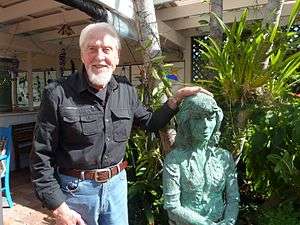Marc Clark
| Marc Clark | |
|---|---|
|
Marc Clark, May 2016 |
Marc Clark[1][2] MA (R.C.A, Lon A.R.C.A.) R.B.A. Born: England 23 October 1923, is an English born Australian sculptor and print maker.
Life
Marc Clark was born in London in 1923. At 14 he enrolled into the Sydney Cooper School of Art in Canterbury where he studied for four years. The war interrupted Clark's studies during which he served with the 9th Queens’ Royal Lancers in North Africa, Sicily, Italy and Austria.[3]
Teaching
After graduation Clark lectured at the Watford College of the Arts, UK, from 1953 to 1962. His first teaching appointment in Australia was with the Caulfield Institute of Technology[4] where he taught basic design. After six months he was appointed Master of Drawing at the National Gallery of Victoria Art School[5] which was later to become the Victorian College of Arts.[4] There, Clark introduced Clay Portraiture and lectured in Human Anatomy.[6] At the time all students were majoring in painting only. The Head of the School was initially John Brack. When the School relocated to its St Kilda Road premises, and was renamed the "Victorian College of the Arts", the Dean was Lenton Parr. Clark was appointed Senior Lecturer in charge of the newly formed Sculpture School[7] that was incorporated into the new College. He often acted as Dean of the Art School. He retired from the College in 1984 but continued as a Visiting Lecturer at Dandenong TAFE, Melbourne University, Harvey Bay Senior College, in Queensland and Deakin University over various periods up until 2007.
Work
"A major preoccupation with his art has been with the notion of timelessness, an art which more that commemorate an individual person's ego or freeze an historical event in time ." Dr. Sasha Grishin.[3]
After graduation Clark produced numerous sculptures in the United Kingdom, including author Peter Cheyney's hands and a death mask of the Welsh painter Evan Walters. He has contributed to monumental works in Australian parks and gardens.[7] These include Sculpture of Captain James Cook, now located at Cooks' Cottage[8] within Fitzroy Gardens in Melbourne, Victoria. In 1971 he was commissioned by the Tongan Government to provide a statue of Queen Sālote Tupou III. This is located at Nuku’alofa, Tonga.[7] In 1983 Clark contributed a cast of the 'Eternal Flame' to the Rats of Tobruk Memorial[9] located in Canberra.
Edmund Barton[10] located at Barton House, in Australia's capital city Canberra, was the next major work completed by Clark in 1981. In 1985-87 he was commissioned to provide three bronze sculptures. The first was Matthew Flinders,[11] R.N., which is located at Mornington Park, Mornington, Victoria, Captain William Bligh R.N.,[12][13] at Cadmans Cottage, Sydney, NSW, and a sculpture of Baron Sir Ferdinand von Mueller [14][15] located within the Botanical Gardens, Melbourne.
Clark has made significant contributions to the Australian Federal Parliament House Art Collection. His works in the collection include 'Alpha and Omega', 'Ancient Sites' and 'Monument to a Hero II [16][17]'.
"Marc Clark is widely acknowledged to be a very accomplished and versatile sculptor who has created with equal assurance a succession of commissioned memorial works on a monumental scale and a large number of other sculptures more personally conceived and motivated by his own powers of observation and invention."Lenton Parr AO[18]
Clark’s abstract works form a human relationship to figurative expression through the portrayal of personal and human elements in geometrical forms. The bronze sculpture Stairway to Nowhere (Now in Queensland Art gallery collection) represents his own experience of the result of bombing in WW2 where functional buildings were transformed into symbols of futility. (Dr Sasha Grishin) [3]
Further reading
- Drawings etc. Published in Transatlantic Review (1959–77), USA, 1960.
- Wrecks and Reputations, Don Charlwood. ISBN 978-0-207-13065-6, 1978.
- Encyclopaedia of Australian Art, Volume No. 1, Pages 202, 203, Alan McCulloch, ISBN 9780522853179, 1984.
- Works of Art in Canberra A.C.T Volume 2. National Capital Development Committee, ISBN 0642099014, 1985.
- Sculpture Mildura, by Graham Sturgeon, 1986, ISBN 0959862196.
- Artists Print Making Statement - http://www.castlemainegallery.com/Exhibitions/Archive/MarcClark/clark.html
References
- ↑ Scarlet, Ken (1980). Australian Sculptures. Nelson. pp. 106, 107. ISBN 0170052923.
- ↑ Germaine, Max (1984). Artists and Galleries of Australia and New Zealand. Boolarong. p. 109. ISBN 0908175876.
- 1 2 3 Grishin, Sasha (1993). "Catalyst of Forms (26)". Art International: 56–59.
- 1 2 Pascoe, Joseph. "Creating the Victorian College of the Arts". Macmillan Education AU. p. 95.
- ↑ Westbrook, Eric (1968). Birth of a Gallery. Macmillan. p. 79.
- ↑ Sturgeon, Graeme (1978). Development of Australian Sculpture from 1788-1975. Thames & Hudson Australia Pty, Limited. p. 201. ISBN 978-0500271162.
- 1 2 3 Men of Achievement. International Biographical Centre. 1984. p. 198. ISBN 0 900332 74 3.
- ↑ Design, UBC Web. "Captain James Cook | Monument Australia". monumentaustralia.org.au. Retrieved 2016-05-20.
- ↑ Design, UBC Web. "Rats of Tobruk Memorial | Monument Australia". monumentaustralia.org.au. Retrieved 2016-05-29.
- ↑ Bill, Pedersen,. "Edmund Barton statue outside Barton Offices, corner of Kings Avenue and Macquarie Street, Barton". www.images.act.gov.au. Retrieved 2016-05-27.
- ↑ Flinders, Mathew (1987). "Snapper Point".
- ↑ Design, UBC Web. "Captain William Bligh | Monument Australia". monumentaustralia.org.au. Retrieved 2016-05-20.
- ↑ Lumley, Ann (1990-01-01). Sydney's Sculpture. Longman Cheshire. ISBN 9780582868205.
- ↑ von Mueller, Ferdinand. "Melbourne Sculptures". Melbourne Sculptures.
- ↑ Centre, The University of Melbourne Scholarship Research. "Search - Encyclopedia of Australian Science". www.eoas.info. Retrieved 2016-05-28.
- ↑ Viellers, Renee (December 17, 2009). "Barnaby Joyce blasts Parliament art sculptures". Monument to a Hero II – via Courier Mail, Brisbane.
- ↑ Expressing Australia, Art in Parliament House. Canberra [A.C.T.] Joint House Department of Parliament House. 1993. pp. 106, 107. ISBN 0642195218.
- ↑ Clark, Biography, Marc (2004). Another Colonial Boy. Copyright Publishing, QLD. pp. Back Cover. ISBN 1 876344 31 8.
